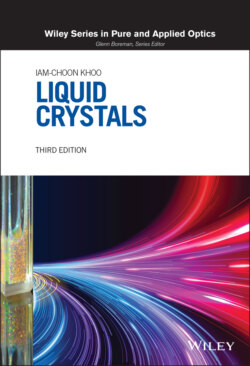Читать книгу Liquid Crystals - Iam-Choon Khoo - Страница 34
2.2. MOLECULAR INTERACTIONS AND PHASE TRANSITIONS
ОглавлениеIn principle, if the electronic structure of a liquid crystal molecule is known, one can deduce the various thermodynamical properties. This is a monumental task in quantum statistical chemistry that has seldom, if ever, been attempted in a quantitative or conclusive way. There are some fairly reliable guidelines, usually obtained empirically, that relate molecular structures with the existence of the liquid crystal mesophases and, less reliably, the corresponding transition temperatures.
One simple observation is that to generate liquid crystals, one should use elongated molecules. This is best illustrated by the nCB homolog [5] (n = 1, 2, 3,…). For n ≤ 4, the material does not exhibit a nematic phase. For n = 5–7, the material possesses a nematic range. For n > 8, smectic phases begin to appear.
Another reliable observation is that the nematic → isotropic phase transition temperature Tc is a good indicator of the thermal stability of the nematic phase [6]; the higher the Tc, the greater is the thermal stability of the nematic phase. In this respect, the types of chemical groups used as substituents in the terminal groups or side chain play a significant role – an increase in the polarizability of the substituent tends to be accompanied by an increase in Tc.
Such molecular‐structure‐based approaches are clearly extremely complex and often tend to yield contradictory predictions because of the wide variation in the molecular electronic structures and intermolecular interactions present. In order to explain the phase transition and the behavior of the order parameter in the vicinity of the phase transition temperature, some simpler physical models have been employed [6]. For the nematic phase, a simple but quite successful approach was introduced by Maier and Saupe [7]. The liquid crystal molecules are treated as rigid rods, which are correlated (described by a long‐range order parameter) with one another by Coulomb interactions. For the isotropic phase, deGennes introduced a Landau type of phase transition theory [1–3], which is based on a short‐range order parameter.
The theoretical formalism for describing the nematic → isotropic phase transition and some of the results and consequences are given in the next section. This is followed by a summary of some of the basic concepts introduced for the isotropic phase.
